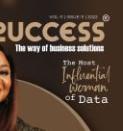













Visionaryleadersineducationserveasagentsoftransformation,redefiningthepurpose,delivery,and
impactoflearning.Theymovebeyondconventionalframeworksbyintegratinginnovationwith inclusivityandaligningpolicywithpracticalimplementation.Throughthestrategicuseoftechnology,a commitmenttoequity,andthepromotionofcriticalthinking,theseleadersarereshapingeducationalsystemsto addressthedemandsofarapidlyevolvingworld.Theireffortsempowerlearners,supporteducators,anddrive institutionalchangetocreatemeaningful,future-orientededucationalexperiences.Amongtheseleadersis RichardLarson,whoadvocatesforanapproachtoeducationthatextendsbeyondtheacquisitionofknowledge, emphasizingthedevelopmentofcriticalthinkingandtheapplicationoflearningtoreal-worldchallenges.
InsightsSuccessinitsrecenteditiontitledEmpoweringGenerations–RichardLarson’sMissionDriven LeadershiphighlightstheremarkablecontributionsofLarson,apioneerinthefieldofoperationsresearch. Throughouthisdistinguishedcareer,Larsonhasadvocatedforeducationalmodelsthatmovebeyondthemere transmissionofknowledge,focusingonequippingstudentswiththetoolstoanalyze,model,andsolvecomplex real-worldproblems.Hisworkhasconsistentlyconnectedacademictheorywithpracticalapplication,influencing criticalareassuchasemergencyresponse,education,publichealth,andurbanlogistics.Withfoundational contributionsinqueuingtheoryandurbanoperations,Larson’scareerreflectsastrongcommitmenttosocietal impactandintellectualexcellence.Asaresearcher,educator,andmentor,hehaschampionedmodel-based thinkingasapowerfulapproachtoenablemoreinformedandeffectivedecision-makingacrossdisciplines.
Larsonemphasizestheimportanceofintegratingtechnologywithhumaninsight,highlightingthecriticalroleof fieldworkandcontextualunderstandingineffectiveproblem-solving.ThroughinitiativessuchasMIT BLOSSOMS,hisleadershipinprofessionalorganizations,andhiscontributionstothereformofNewYorkCity's 911system,hehasconsistentlypursuedavisionofamoreefficientandequitableworld.Byaligninganalytical toolswithreal-worldhumanneeds,Larson’sworkexemplifiesthepowerofappliedresearchandservesasan enduringmodelforfuturescholarsdedicatedtobothinnovationandsocietalimpact.
Haveagreatreadahead!




























School administration in the contemporary age of
education must transcend its ordinary administrative functions. It must adopt a leadership approach that encouragesinnovation,inclusivity,andresilience.Becoming emanatingschoolsbycultureofpracticeininnovationisnot an option but a necessity to attain academic excellence, students' well-being, and institutional stability Effective schoolleadersareawarethateducationrequiresanintegrated strategy to succeed that encourages teamwork, embraces change, and focuses on development for students and teachers.Schoolleadershipinthelifeofschoolstodayisnot just a matter of maintaining what exists. It involves creating vision, establishing trust, encouraging professional development, and addressing changing needs of varying schoolcommunities.Visionaryleaderswiththeinclinationto adoptnewapproachesaremorelikelytoimprovetheability ofschoolstorespondtothedemandsofthe21stcentury,fix thesystemproblems,andcreatecircumstancesinwhichevery learnerthrives.
The following article outlines three essential strategies that drive school transformation through effective transformational leadership: establishing a clear and compelling vision, fostering a collaborative school culture, and leveraging technology strategically to enhance learning andorganizationaleffectiveness.
Visionary leadership supports long-term school growth. Visionary leaders with a clear direction of vision are able to co-ordinate the work of staff, students, and the local communitytoasharedpurpose.Suchcleardirectionofvision isprovidingdirection,purpose,andmotivationforsustained development A clear vision is a clear policy-making, decision-making, and instructional design principle of


direction. This strengthens school communities to be more resilient even during periods of uncertainty or change. Visionary leaders also subscribe to equity, access, and innovationsincetheyconstructthatvision.
Theyactivelyengageindeterminingtheindividualizedneeds of their school community and adopting measures to solve them.Theystrategicallyplanandanticipateimpendingfuture educationissuessuchasincorporationofnewtechnologyor revisions in curriculum standards. They also utilize data to inform decisions, using results of assessments, attendance, and behavior trends as forms of feedback rather than punishmenttoenhancelearningopportunities.
Developingcollaborativeschoolcultureisessentialtospark innovation and ongoing improvement. Where teachers, students,parents,andcommunitymembersuniteforcommon goals, the whole school gains with greater sense of responsibility and ownership. Innovative leaders build this culture by facilitating communication, inclusiveness, and shared leadership They understand that involving all concerned guarantees improved decision making and programimplementation.
Developingprofessionallearningcommunities(PLCs)isone of the key factors of a collaborative culture. Professional learning communities are groups of teachers who have continuous conversation, reflection practice, and problemsolving collaboratively They learn from student learning data,exchangeteachingpractices,andworktogethertosolve classroom issues. The collaborative environment provides professional development, eradicates isolation, and makes innovationthrive.Moreover,bygivingteachersautonomyto lead in their role, the teachers themselves become agents of change who bring about a spirit of openness to continuous improvement.Thisspiritofempowermentmustextendeven tothestudents.Allthoseschoolsthatintroducestudentvoice into school culture, curriculum design, and after-school activities find their students' participation and engagement enhanced.
Technology is leading the way in developing innovative approachestoteachingandleadership.Schoolleaderstoday
are not only required to know about digital technology but also apply it effectively to help augment learning goals. Technology can further aid in augmenting communications, automating bureaucracies, improving data collection, and facilitating professional networking. Learning management systems,cloud-basedinitiatives,anddigitaldashboardsallow school leaders to monitor progress, communicate expectations, and connect stakeholders with clarity and efficiency. In the classroom, technology can customize learningandengagestudentsinnewandmeaningfulways.
Technology facilitates more effective participation and improved student outcomes through virtual collaboration, gamified learning environments, or flipped classrooms Technologyalsoequipsstudentswiththerightdigitalliteracy that will be of great use in their future learning and professionallives.Technology,however,canonlyachieveits maximum potential by being complemented with constant support, training, and access on an equal basis. Administrators must invest in professional development training that equips the teachers with skills in digital tools. Administrators must also equip the students with the necessary tools, e.g., devices and internet connectivity, that allow them to participate actively in technology-mediated learning.
Conclusion
Equippingschoolswithnewleadershippracticesisessential topreparingstudentsforsuccessinanincreasinglyhigh-tech, complex world. Three key areas where leaders can exert maximum impact are visionary planning, creating culture throughcollaboration,andthoughtfultechnologyintegration. These are not one-shot activities but rather part of systemlevel strategies that collectively create caring, compelling learning communities. As districts grapple with issues of equity, engagement, and performance, leaders are asked to bend, innovate, and lead with heart Empowering others—students, teachers, and families—builds trust and maintainsasharedpursuitofexcellence.Byinnovatingasa mindset, not as a momentary fad, school leaders create conditions for sustainable change. Their leadership is the cornerstone upon which extraordinary schools that are resilient,inclusive,andforward-thinkingareconstructed.




www.insightssuccessmagazine com











In today’s rapidly evolving business landscape, leadership demandsareshiftingdramatically Thetraditionalcommandand-control approach is no longer sufficient to inspire, engage, and empower teams to deliver exceptional results. Instead,forward-thinkingorganizationsareembracingnextgenerationleadershiptechniquesthatfocusonunlockingthe full potential of their people.These contemporary strategies harness emotional intelligence, agility, and inclusivity to cultivateenvironmentswhereinnovationandgrowthflourish. This article explores how these next-gen leadership techniques unlock organizational and individual potential, drivingsustainedsuccessinanincreasinglycomplexworld.
Oneofthedefiningfeaturesofnext-generationleadershipis theprioritizationofemotionalintelligence(EI)—theability torecognize,understand,andmanageemotionsinoneselfand others.LeaderswhocultivateEIfosterstrongerinterpersonal relationships, build trust, and navigate conflicts with greater empathy. Emotional intelligence allows leaders to tune into the needs and motivations of their teams, creating a supportive culture where employees feel valued and heard. This emotional resonance boosts morale and drives engagement, which are critical for unlocking individual potential.
Moreover, emotionally intelligent leaders excel in selfawareness and self-regulation, enabling them to respond thoughtfully rather than react impulsively. This quality is especially important in high-pressure situations, where measuredresponsescanpreventescalationandmaintainteam cohesion. In volatile environments, this composure model’s


resilience and stability, inspiring confidence across the organization.Byleveragingemotionalintelligence,next-gen leaders create psychologically safe workplaces where risktaking and creativity are encouraged, ultimately unlocking new levels of performance and innovation Emotional intelligence also enhances communication effectiveness Leaderswhounderstandandmanageemotionscommunicate withclarityandcompassion,reducingmisunderstandingsand fosteringcollaboration.
In an era defined by disruption and uncertainty, agility has become a cornerstone of effective leadership Nextgeneration leaders recognize that rigid hierarchies and fixed strategies can hinder progress Instead, they embrace flexibility, adaptability, and continuous learning as core leadership competencies. Agility enables leaders to pivot quickly in response to shifting market demands, technological advances, or competitive pressures. This capacity to adapt not only protects organizations from stagnationbutalsoopenspathwaystonewopportunities.
Agileleadershipinvolvesamindsetthatviewschangenotasa threatbutasanopportunityforgrowth.Leaderswhoembody this approach encourage experimentation and learning from failure.Byfosteringacultureofinnovationwhereemployees feelsafetotakecalculatedrisks,agileleadersunlockcreative potentialacrossalllevelsoftheorganization.Thisapproach democratizes decision-making, empowering individuals to contribute insights and take ownership of outcomes, which accelerates problem-solving and innovation. Additionally, agile leaders prioritize continuous feedback loops and iterative processes to refine strategies and operations. This responsivenessenablesorganizationstostayaheadoftrends and competitors while maintaining alignment with evolving customerneeds.
Diversity and inclusion have emerged as vital elements of next-gen leadership, reflecting a broader understanding of how varied perspectives fuel innovation. Inclusive leaders intentionally create environments where diverse voices are notonlywelcomedbutleveragedforstrategicadvantage.By recognizing and appreciating different backgrounds, experiences,andviewpoints,theseleadersunlockawealthof untapped talent and creativity. Inclusion fosters psychological safety, ensuring all team members feel
respected and empowered to contribute their best ideas. Inclusive leadership requires humility, cultural competence, andacommitmenttocontinuouslearning.
Next-genleadersactivelyseektochallengetheirunconscious biases and foster equitable opportunities for all employees. Thiscreatesacultureoffairnessandbelongingthatenhances engagementandretention.Bypromotingdiversityofthought and experience, inclusive leaders enable organizations to solvecomplexproblemsmoreeffectivelyandinnovatemore broadly. Furthermore, inclusive leadership supports collaboration and trust within teams, which are critical for achieving collective goals. When employees feel genuinely included and valued, they are more likely to bring their authentic selves to work and contribute fully This enriched environmentunlockshigherlevelsofcreativity,productivity, and satisfaction. Companies that prioritize inclusion demonstrate better financial performance and stronger reputations, underscoring the strategic value of this leadershipapproach.
The complexities of the modern business world demand leadership approaches that are dynamic, empathetic, and inclusive. Next-generation leadership techniques — groundedinemotionalintelligence,agility,andinclusivity— offer powerful tools to unlock the latent potential within individuals and organizations By fostering deeper connections, embracing change with flexibility, and harnessing diverse perspectives, leaders can create cultures where innovation and growth are the norm rather than the exception. Organizations that invest in developing these leadership capabilities position themselves to thrive amid uncertainty and disruption. Unlocking potential is no longer about commanding from the top but enabling from within, empowering people to bring their best ideas and efforts forward.Asbusinessescontinuetonavigateanever-evolving landscape, next-gen leadership will be the catalyst that transforms challenges into opportunities and potential into performance. Embracing these techniques is not simply a trendbutastrategicimperativeforsustainablesuccess.







